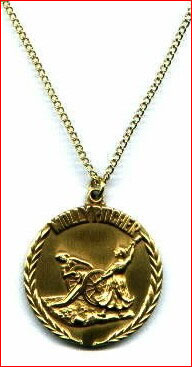~ ARTILLERY LEGENDS ~
Submitted by Sergeant Major Jack Love, Field Artillery, US Army Retired.
Saint Barbara is the patron saint of all field artillerymen. Every fall, at Fort Sill, Oklahoma, the separate Regiments and the Post hold Saint Barbara Balls. The dress is formal, blues or a tuxedo.
The evening is a full dinner party with drinks and dancing. A formal awards event [this is a highly orchestrated show by younger officers ending with a toast to the FA with Artillery punch that will knock your socks off] is included to recognize artillerlymen and their ladies. The awards are: the Ancient Order of Saint Barbara, the Honorable Order of Saint Barbara and the Artillery Order of Molly Pitcher for the ladies. Very few people hold the Ancient Order which is only awarded to the "best of the best" and authorized by a General Officer. The Honorable Order of Saint Barbara is awarded to exceptional artillerymen and authorized by a Regimental Commander. The Artillery Order of Molly Pitcher is awarded to women who support the field artillery in many way and awarded by a Regimental Commander.
I have been awarded the Ancient Order of Saint Barbara which is a gold medallion on a scarlet neck ribbon. All others are silver.
My wife, Mary, has been awarded the Artillery Order of Molly Pitcher.
![]()


(Left) Jack Love at recent Saint Barbara Ball, Ft. Sill, OK. (Right) Saint Barbara, Patron Saint of Artillery.
Legend of Saint Barbara
According to legend, the artillery's patron saint was the beautiful daughter of Dioscorus, a nobleman of the Roman Empire, believed to have lived in Nicomedia in Asia Minor about the Third or Fourth Century AD.
To limit Barbara's exposure to Christianity and encourage her development as a zealous pagan, her father kept her shut up in a tower, lighted by only two windows.
But from these windows she looked out upon the surrounding countryside and marveled at the living things. She concluded that they all must be part of a master plan and that the idols of wood and stone worshipped by her parents had to be condemned as false. She obtained instruction in Christianity and was baptized. In token of her faith while her father was away, she had another window pierced in the tower, making three, symbolizing the Holy Trinity. On his return Dioscorus asked why she had made this change and Barbara acknowledged her conversion. Despite his threats, she refused to renounce Christianity.
He delivered her to a Roman magistrate, who, even after torture, failed to persuade her. Dioscorus himself then took his daughter to a high mountain, where he, beheaded her. As he descended the mountain, he was caught in a sudden violent storm. In a blinding flash he was consumed by lightning.
As a logical consequence, Barbara came to be regarded as the sainted patroness of those in danger from thunderstorms, fire, and explosions -- that is to say, sudden death. Given the questionable reliability of early cannons - misfires, muzzle bursts, and exploding weapons were not uncommon-it is easy to see why our predecessors sought the protection of Saint Barbara. She has protected us ever since.

Jack Love 's Ancient Order of Saint Barbara Medallion.
![]()


(Left) Mary Love's Artillery Order of Molly Pitcher Medallion. (Right) Molly Pitcher.
Mary Ludwig Hays McCauley
[ Molly Pitcher ]
October 13, 1754 - July 22, 1833
Mary Ludwig was born on October 13, 1754 near Philadelphia, Pennsylvania. Her parents had come to the colonies from Germany. At the age of 15, she became a servant to Dr. William Irvine, who later became a Brigadier General in the Continental Army and led men in the Battle of Monmouth.
Later she married John Casper Hays, a barber. John Hays enlisted in the Continental Army in 1775 and Molly often traveled with him to the battlefields. She was one of the women at Valley Forge the winter of 1778. She got the nickname "Molly Pitcher" because she would bring pitchers of cool water from nearby streams or wells to the thirsty soldiers.
Her reputation really became known after the Battle of Monmouth on June 27, 1778. As cold as it had been in Valley Forge, that was as hot as it was on this June day. She brought pitcher after pitcher of cool spring water to the exhausted and thirsty men. She took care of wounded men and carried a wounded Continental soldier to safety.
When she saw her husband fall from heat stroke, she took his place and helped fire the cannon. If she had not have taken over for her husband, that unit would have had to retreat which may have given the British an advantage. However, her determination to fight for her country during this battle became legendary and may have even saved the Continental Army from having lost this battle.
After the Battle of Monmouth, Molly Pitcher and her husband returned to Carlise, Pennsylvania, not too far from Philadelphia. John Hays died in 1789. She later married George McCauley, but it doesn't seem that they were real happy.
When General George Washington heard about her heroic acts, he made her a noncommissioned officer and she became known as "Sergeant Molly." In 1822, the Pennsylvania legislature passed an act that gave her $40 a year for the rest of her life because of what she did during the Revolutionary War.
Mary Ludwig Hays McCauley died in Carlisle, Pennsylvania on July 22, 1833. At her graveside there is a flagstaff, a cannon and a monument honoring her as a hero.
![]()